A sparkling gem on the Costa del Sol, glamorous Marbella lies about an hour’s drive to the east of Malaga and basks in virtually year-round sunshine.
Here, lavish villas sprawl along emerald golf courses, while prestigious hotels line the soft sand beaches of the “Golden Mile”, a stretch of Spain’s most expensive real estate. A range of dusky coastal mountains, the Sierra Blanca, forms an inviting backdrop to the coastal development, their slopes sprinkled with the region’s famous pueblos blancos, or white villages.
Marbella may appear to be all glitz and designer shopping, but it’s actually a lovely old town with a centuries-long history, long, sandy beaches, and a thriving culinary scene. So spend some time here to discover what’s beneath that glossy veneer.
Why Visit Marbella
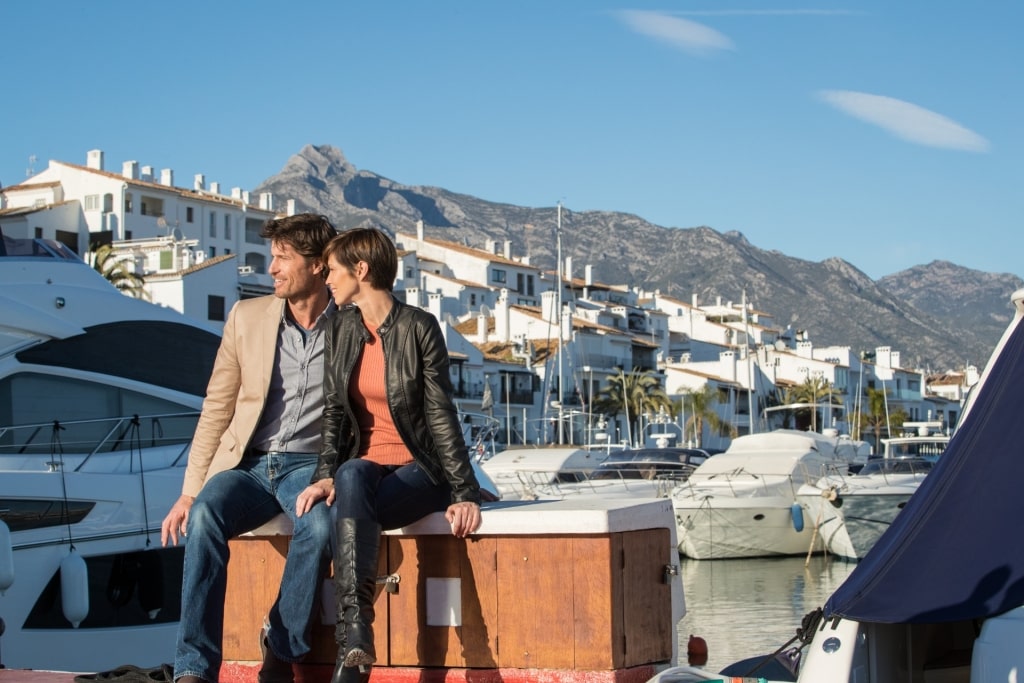
Puerto Banus
Marbella, or “Marbs”, as expats call it, offers a taste of the most luxurious living along the famous Costa del Sol. Just wandering around the old center or the neighboring yacht marina of Puerto Banus is enough to feel a little of that A-list sparkle rubbing off on you.
This luxurious city is a magnet to the wealthy; actors Antonio Banderas and Eva Longoria have homes here, and there’s a long-standing association with the Saudi royal family. In Puerto Banus, you’ll see private yachts with their own helicopters and submarines.
But there’s more to Marbella than people-watching. You can explore the history of the old center, which dates back to pre-Roman times, or book a round of golf at one of the world-class courses. As one of the best beach towns in Spain, you can also try local food in a beach chiringuito, stroll the seafront promenade, bask on the sandy beaches, or head to the hinterland for a hike through nature.
History & Culture
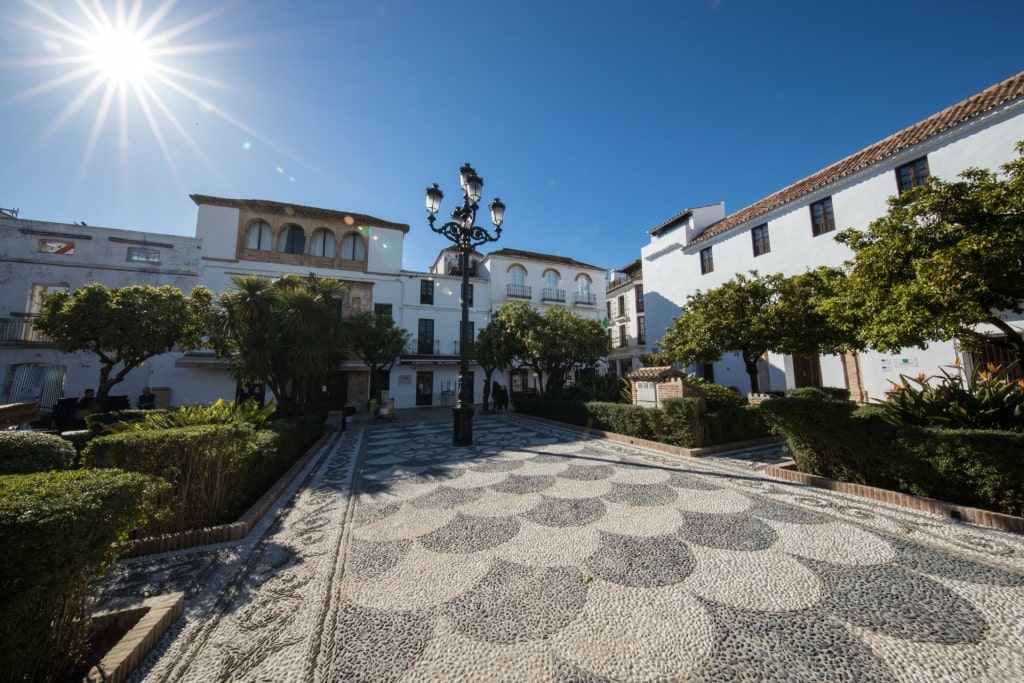
Marbella
A village is believed to have existed on the site of what’s now Marbella, Spain in the times of the Phoenicians, in the seventh century BC. There’s also evidence that the Romans inhabited the town.
In the eighth century AD, Moorish tribes from North Africa invaded Iberia and ruled southern Spain for centuries, staying in Marbella until 1485. The Moors left behind many elements of their culture, from the city walls to place names, language, and cuisine, all of which continue to shape Andalucia today.
In the 19th century, the main source of income in Marbella was the nearby iron industry, and when that collapsed, fishing. It was only in the 20th century that the town was put on the international jet-setting map. Prince Alfonso of Hohenlohe-Langenburg, a European aristocrat, bought a beachfront estate and opened it as the Marbella Club in 1954, attracting the first royals and celebrities to the Costa del Sol.
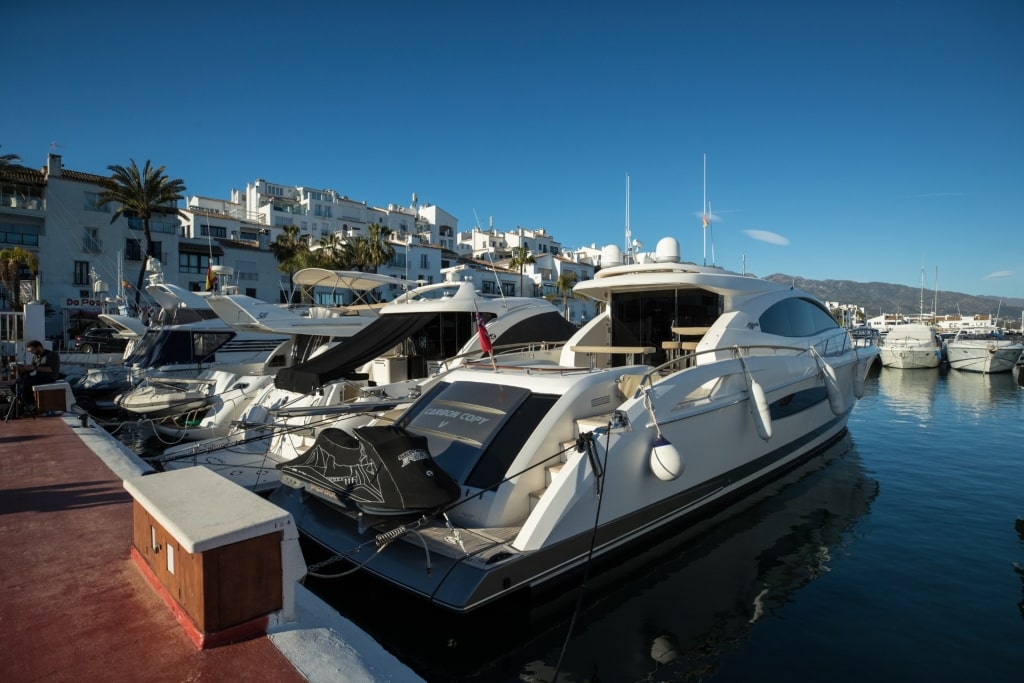
Puerto Banus
In 1966, a local developer, José Banus, in conjunction with the prince, commissioned an architect to build a marina, Puerto Banus, along the coast, which accommodates some of the biggest superyachts in the world.
Everybody who was anybody came to Marbella, from Grace Kelly and Brigitte Bardot to Sean Connery. The town continues to thrive today as one of the most glamorous locations in Spain, with a multicultural year-round community.
Wildlife & Nature
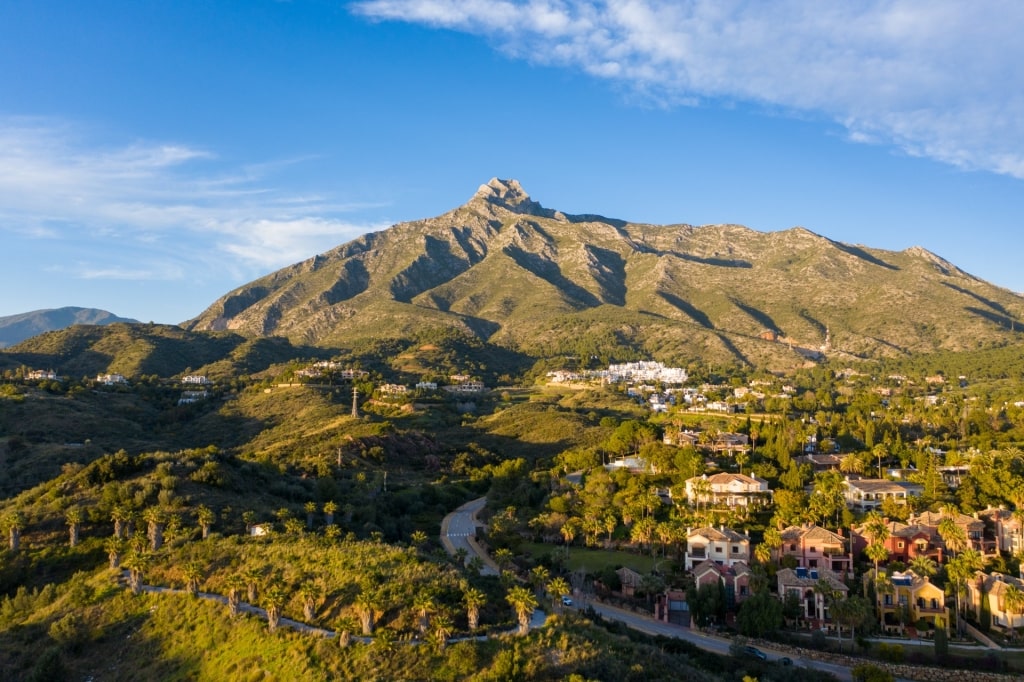
La Concha
While you’re unlikely to spot wildlife in the urban area, there is plenty of natural beauty to be found close to Marbella. The Eco Reserva Ojén is just 10 minutes’ drive from the town and makes a good trip with kids; you’ll see mouflon, deer, and Spanish ibex roaming free here. Take a 4×4 safari with a guide, or follow the wooded hiking trails.
With time to spare, you could tackle the hike up La Concha, the shell-shaped mountain that overlooks the town. Here, you’ll wander through pine and chestnut forests and may encounter goats, foxes, wild boar, and griffon vultures. On a clear day, there are views as far as Gibraltar and Morocco from the top.
It’s possible to join a dolphin-spotting cruise from Marbella, too. Sightings aren’t guaranteed, but there is a thriving population of marine mammals in the sea here. You could spot common, striped, and bottlenose dolphins with an eagle-eyed guide. Further along the coast, towards Gibraltar, there are also pods of resident orca.
Tips for Visiting Marbella
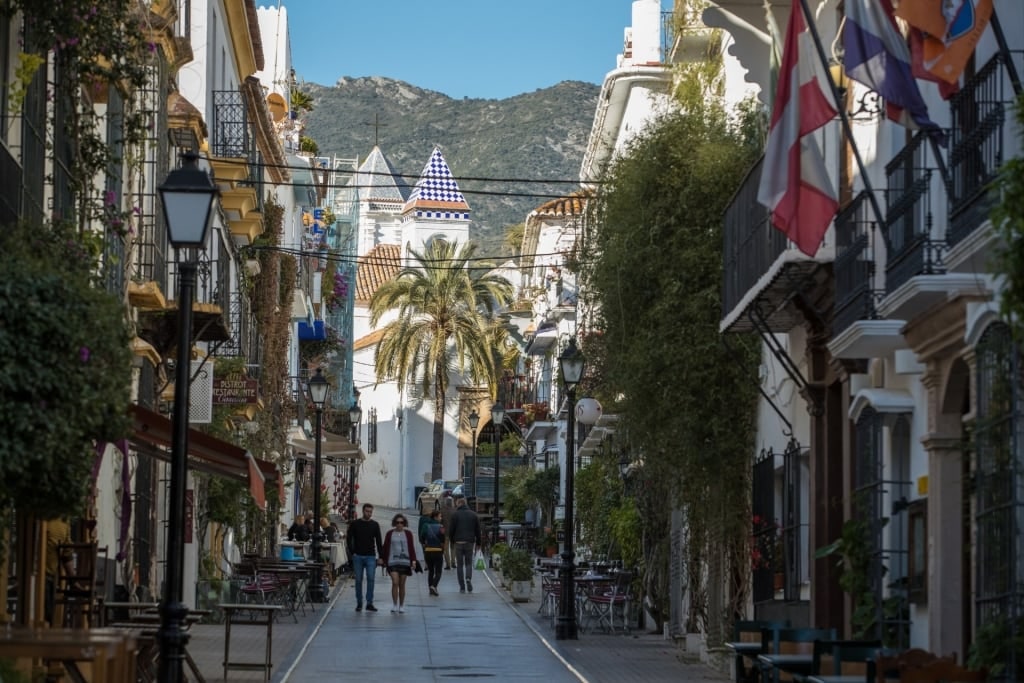
Marbella
If you’re going to eat and drink in Marbella, choose your venue carefully, as prices can be inflated. Any restaurant in a back street, away from the main tourist thoroughfares, is likely to be more competitively priced.
Sherry is drunk here as a traditional aperitif, particularly the dry, white manzanilla, which is served chilled. If you’re drinking in a traditional tapas bar, don’t be surprised if a small, free plate of food arrives with every round of drinks. This is typical of Andalucia and is not entirely about generosity; the theory is that salty snacks make you thirsty, so you’ll order more drinks.
You can pay for plates of tapas, too, which are supposed to be shared. If you’re hungry, raciones are slightly larger sharing plates.
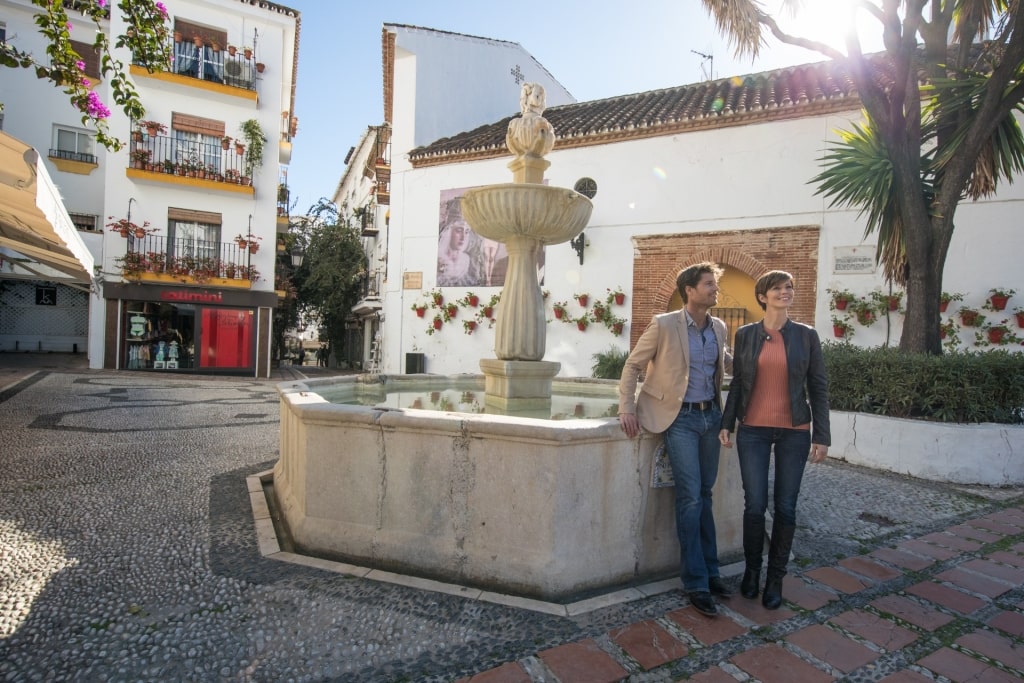
Marbella
Southern Spain gets extremely hot in summer, so do as the locals do and pace yourself. Take a siesta in the middle of the day, or relax in the shade of a beach umbrella. Some local shops may close for lunch, although less so in the big shopping malls.
Things to Do & Attractions in Marbella, Spain
Explore the Old Town
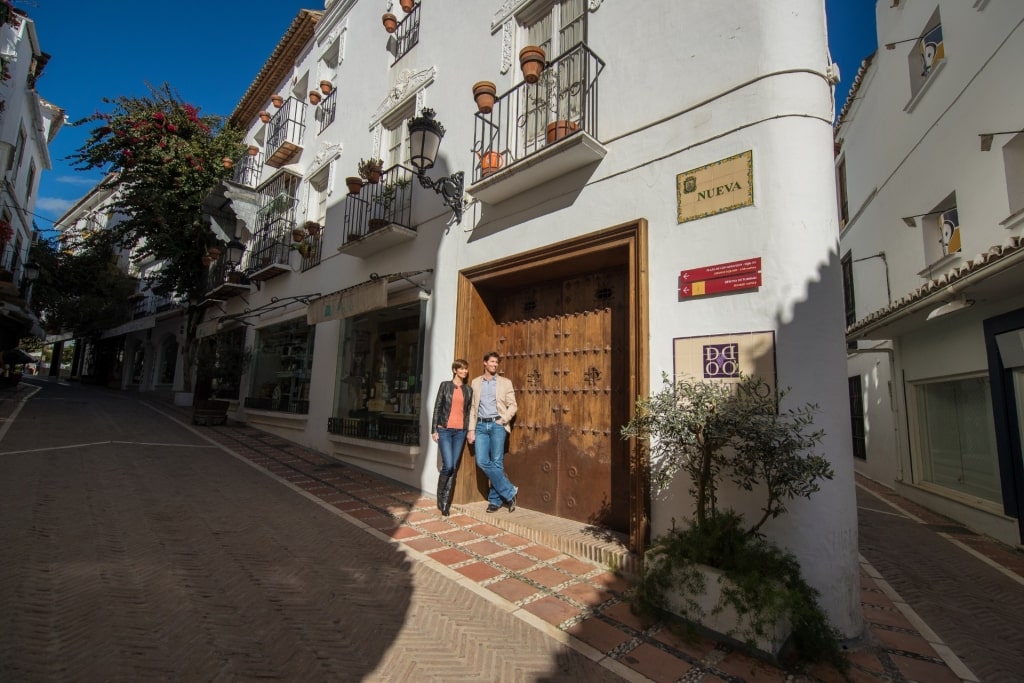
Old Town
Marbella’s casco antiguo, or historic center, is typically Andalucian, with low-rise, whitewashed buildings, cobblestone squares, and local bars with tables spilling out onto the sidewalk.
The Plaza de Los Naranjos (Orange Tree Square) is the heart of the city, lined with fragrant orange trees. You’ll see some impressively old buildings here; the square itself dates back to 1485, while the Town Hall is from the 16th century and the Casa del Corregidor, the 17th century.
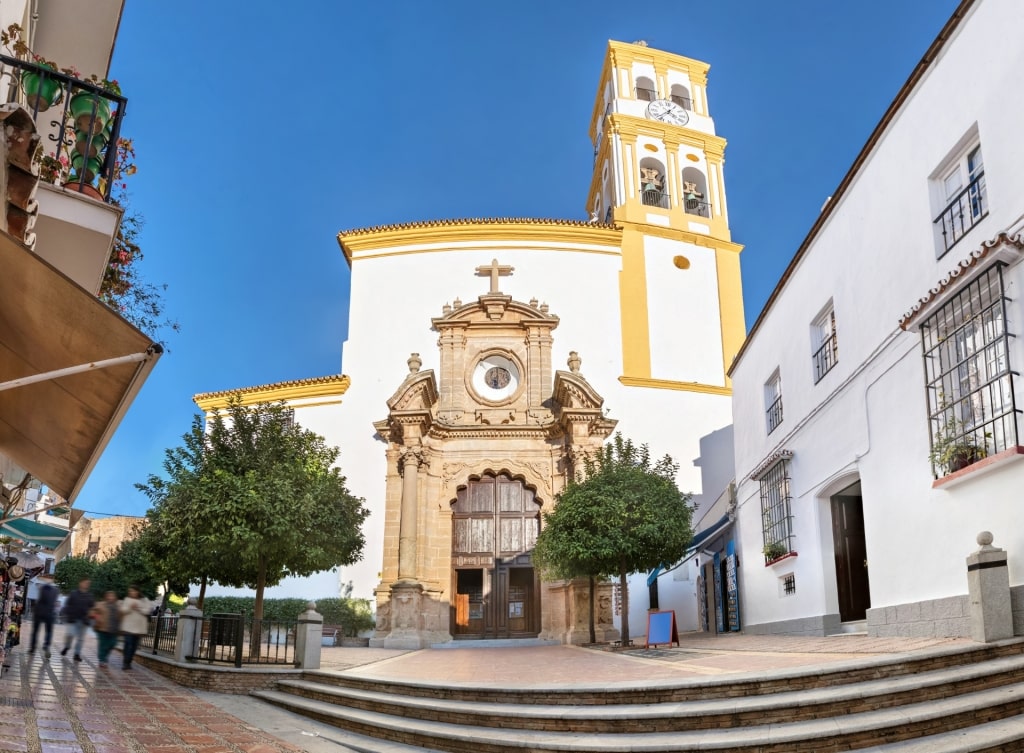
Church of Our Lady of the Incarnation
A couple of minutes’ walk from the Plaza de los Naranjos is the Iglesia de Nuestra Señora de la Encarnación, or the Church of Our Lady of the Incarnation, a 400-year-old whitewashed church built on the site of a former mosque.
It’s worth taking a look at the church’s interior. Walk through the rococo-sculpted front entrance into a world of gilded cherubs and opulently decorated chapels. There’s an impressive, 5,000-pipe organ, too.
Visit the Museum of Spanish Contemporary Engraving
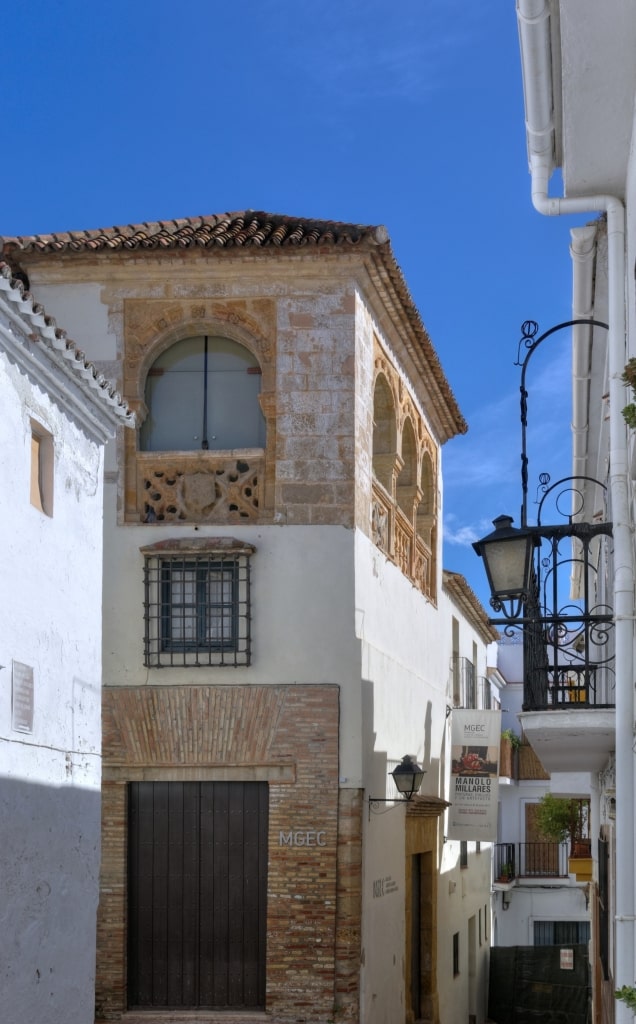
Museo Del Grabado Photo by Berthold Werner on Wikimedia Commons, licensed under CC BY-SA 3.0
Picasso, Miró, and Dalí are more famous for their paintings and sketches, but you’ll find examples from each in the Museo Del Grabado, which has an impressive collection of lithographs, etchings, stencils, and digital prints.
The museum is housed in a Renaissance building that was the mayor’s home before it was donated to the city to serve as a hospital. Later, it was refurbished as a museum. While a visit here is something of a specialist interest, the 4,000-strong collection is regarded as one of the finest in Spain, and there are regular workshops and organized activities.
Head for the Beach
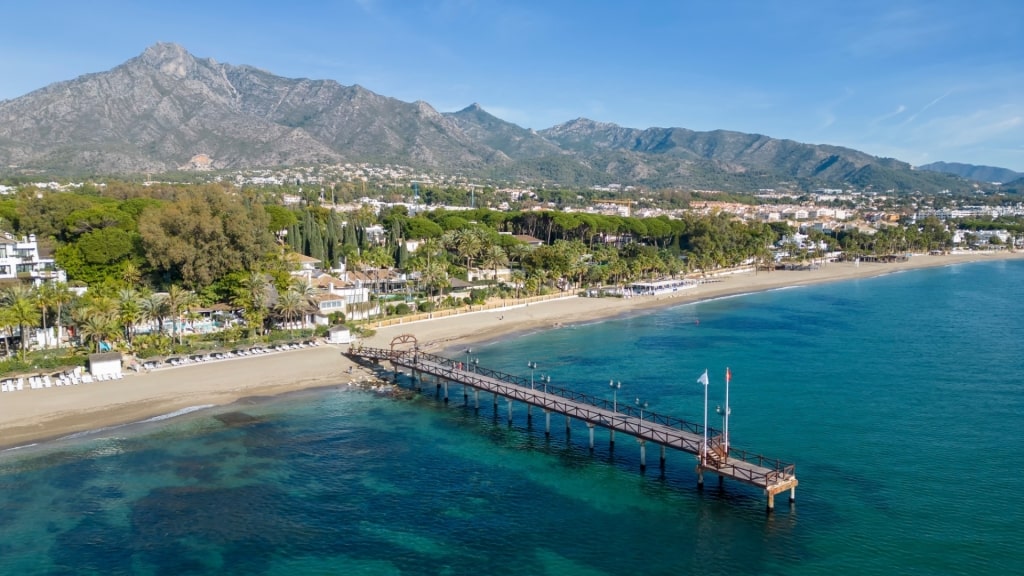
El Ancon
The coast around Marbella is lined with sandy beaches, which vary from super-hip and busy to peaceful and relatively undeveloped. The sand on the Costa del Sol is coarse and dark gold in color, while the sea floor slopes away gently.
El Ancón is on the Golden Mile, backed by palm trees and villas, and not too busy apart from in peak season. Victor’s Beach Bar is a popular and long-established haunt here.
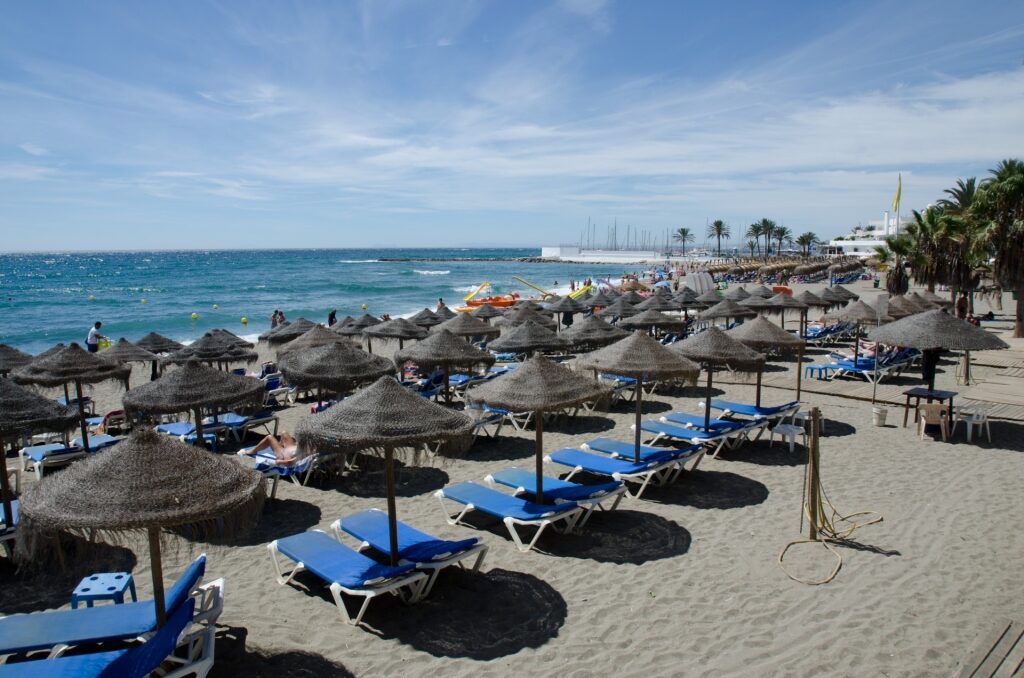
La Venus
La Venus is right in the city center, with thatched sun umbrellas giving it a tropical feel. Nearby Bounty Beach is one of the most fashionable hangouts, with some shade from palm trees if you don’t want to rent an umbrella.
Playa de Nagueles is another people-watching hotspot, next to the swish Puente Romano development to the west of the center. You’ll find everything here, from umbrellas to rent, beach massage, and watersports. There’s a high-end beach restaurant here, La Milla Marbella, which you’ll need to book in advance.
Read: Best Beaches in Southern Spain
Wander Along the Seafront Promenade
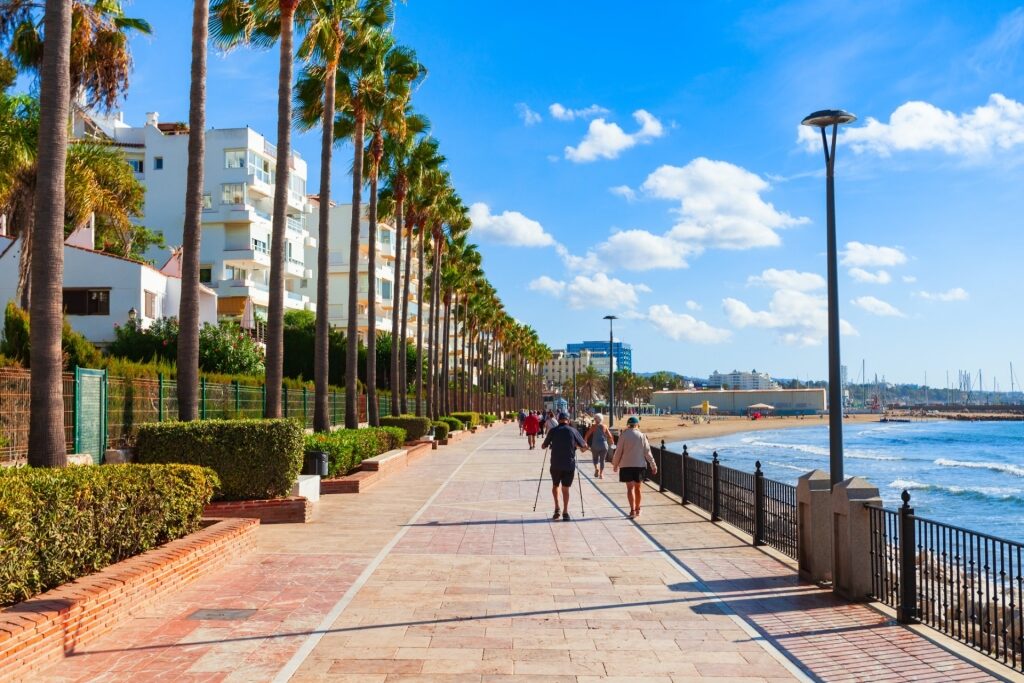
Promenade
A waterfront promenade lined with palm trees, flowers, and beaches runs around seven and a half miles along the coastline of Marbella, starting at Puerto Bajadilla to the east of the city and extending west all the way to Puerto Banus. It’s part of the much longer Malaga Coastal Path, which winds the length of Malaga Province.
If it’s not too hot, you’ll see joggers and cyclists here, as well as dog walkers and locals out strolling and breathing the sea air. You’ll find outdoor gym equipment, free to use, play areas for kids, and no end of cafés and tapas bars for refreshment. You can always take a detour to one of the beaches for a dip.
Gaze at the Yachts in Puerto Banus
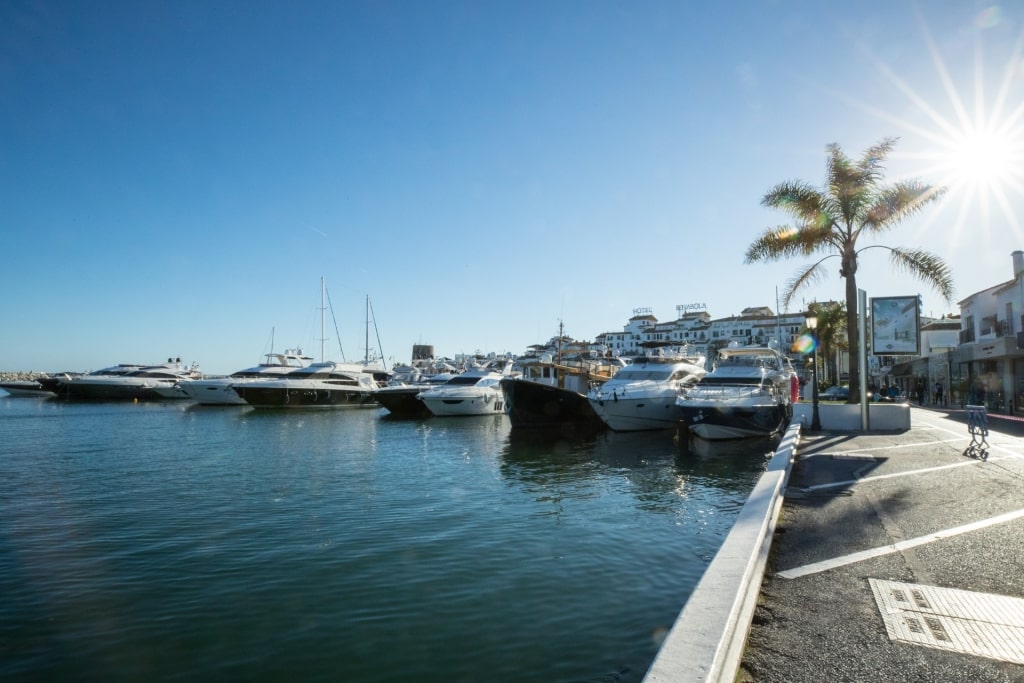
Puerto Banus
A 20-minute drive along the coast from Marbella is Puerto Banus, a purpose-built yacht marina in the style of a traditional Andalucian village. There’s nothing village-like about the labels here, with high-end boutiques lining the alleys around the yacht basin, but it’s a fun spot for a stroll if you like celebrity-spotting.
The port opened in 1970, at which time there was barely any development along the coast. The vision of its founder, José Banus, was successful, and some of the biggest private yachts in the world are moored here in summer.
If you’re visiting Marbella in the height of summer, when it can be very hot, a fun way to make the journey to Puerto Banus is on the Fly Blue catamaran ferry. This service departs Marbella’s port on the hour and takes 30 minutes, operating from March to November. Book ahead, though.
Play a Round of Golf
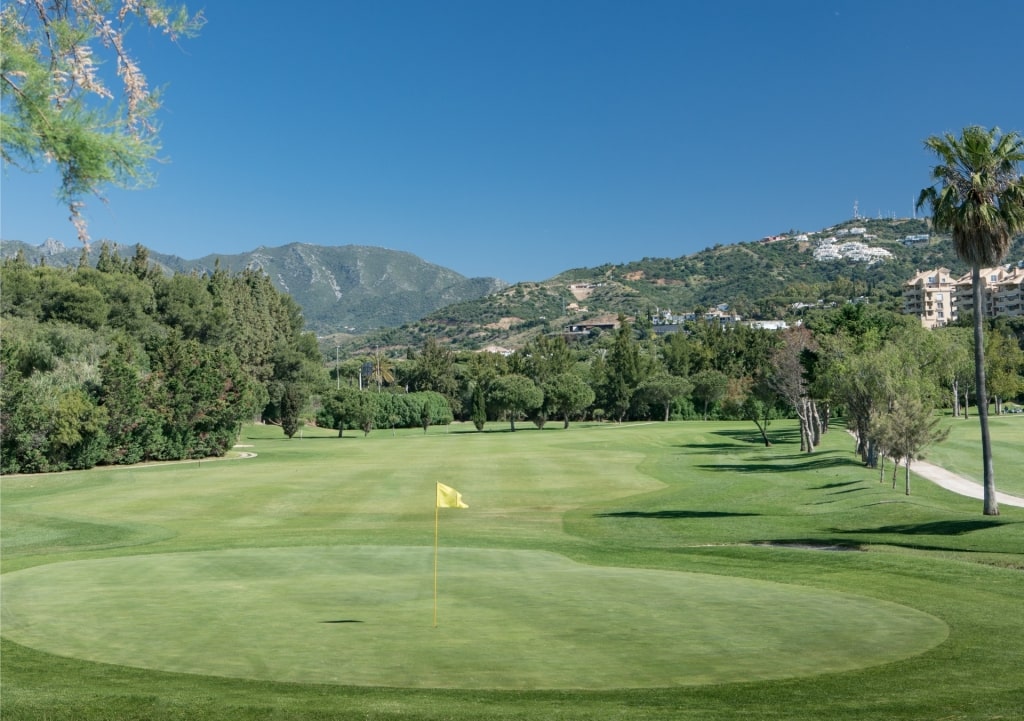
Golf course in Marbella
The coastline of the Costa del Sol is lined with velvet-green courses that host many high-level tournaments; there are 19 courses within the Marbella municipality alone. Plenty of the courses are open to the public, provided you book ahead and come suitably attired, ideally with your handicap certificate.
Los Naranjos is a beautiful 18-hole course, some of the fairways lined with orange trees, as the name suggests. La Quinta Golf & Country Club, five minutes’ drive from Puerto Banus, is a 27-hole course with three different combinations.
For less experienced players, Cabopino Golf Marbella, a par 71 course, is regarded as one of the most beginner-friendly.
Food & Drink
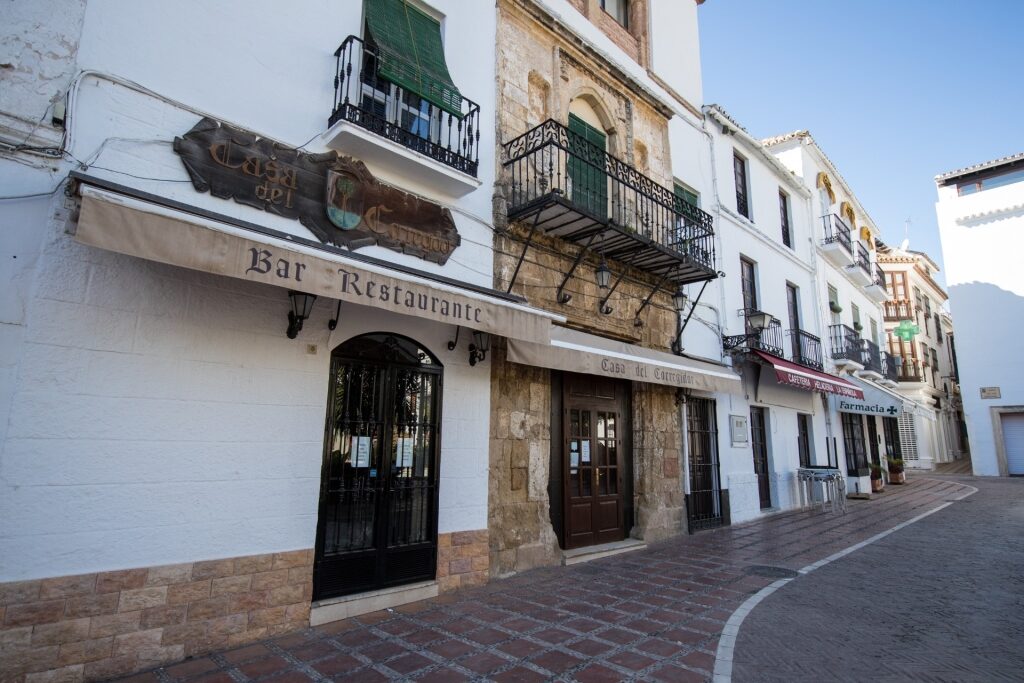
Restaurants in Marbella
Marbella, like much of the Costa del Sol, is famed for tapas, seafood, gazpacho, which is perfect on a hot day, and ajoblanco, a soup with garlic, almonds, and olive oil.
You’ll find everything from Michelin-starred restaurants to Irish pubs and even a Hard Rock Café here, but the best local food is to be found in tapas bars and the chiringuitos, the more informal beach restaurants.
Restaurante Altamirano, Plaza Altamirano
This local institution has been on the scene for 40 years and is an atmospheric place to try seafood, with an extensive menu. If you only opt for a snack at the bar, try the boquerones, which are tiny, battered anchovies eaten whole.
Taberna La Niña Del Pisto, Calle San Lazaro
Visit this traditional Andalucian bar in the heart of the old town for authentic tapas, with influences from Cordoba, further north. The gazpacho is legendary, while vegetarians will love pisto, a Spanish take on ratatouille, bursting with Mediterranean sunshine and perfect with slices of Manchego cheese and crusty bread.
Siroko Beach Club and Restaurant, Avenida Jardin de los Pinos
No visit to southern Spain is complete without a meal in a chiringuito, the seasonal beachfront restaurants that pop up every summer. Siroko, an upscale chiringuito just east of Marbella’s center, offers a modern Mediterranean menu with plenty of sharing dishes, fresh seafood, pizza, and even a vegetarian menu.
You’ll eat right on the beach, toes in the sand. There are DJ tunes in the afternoons and Balinese beds for a siesta after lunch.
Best Time to Visit Marbella, Spain
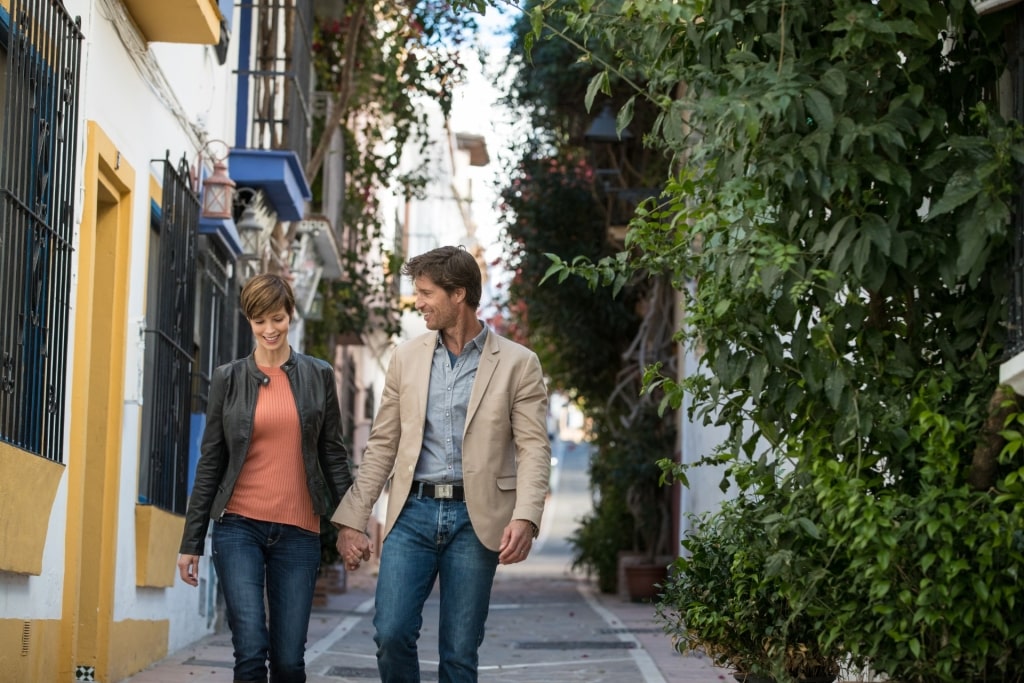
Marbella
One of the reasons Spain’s Costa del Sol is so popular is that it’s sunny virtually all year round. As such, there’s a large, permanent community here and none of the out-of-season feel of some places that have more defined seasons.
In the summer months, the weather is hot and dry, with long days of unbroken sunshine and daily highs of around 86°F, or 30°C. This is a time for slow living, gentle strolls, boat trips, and beach time.
Even in November, you can expect temperatures of around 64°F, or 17.8°C, with only occasional rain. The sea cools down in fall, but you’ll still see people on the beaches. Make the most of the cooler weather with long walks, al-fresco lunches, and a relaxed round of golf.
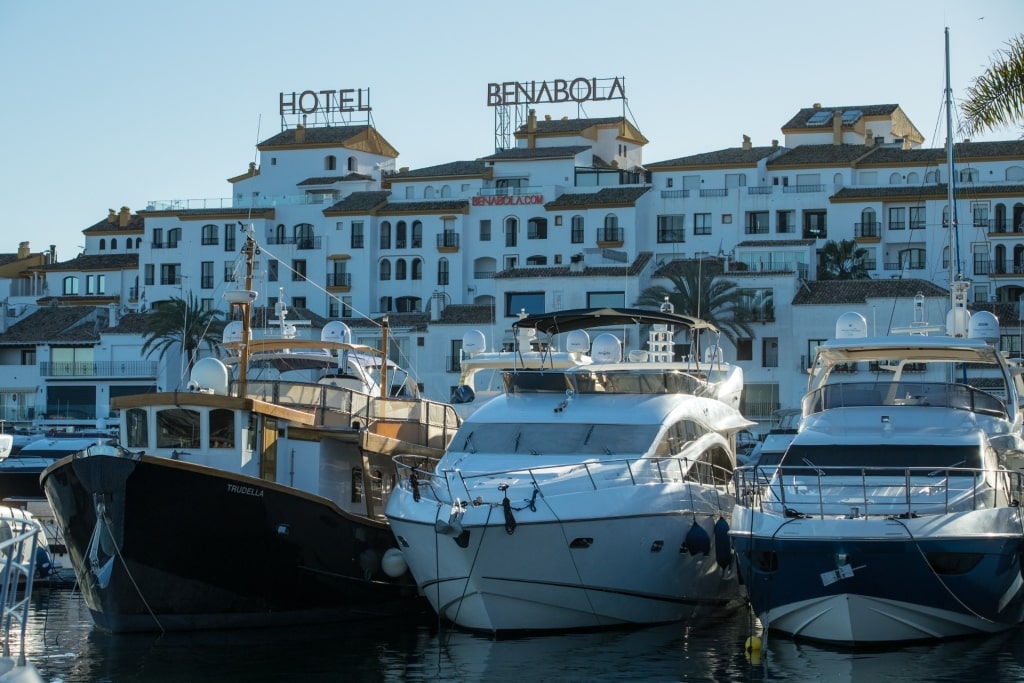
Puerto Banus
Tempted to soak up a little of the glamor or Marbella, Spain? Browse Celebrity’s Malaga cruises here and plan your Spanish adventure.



